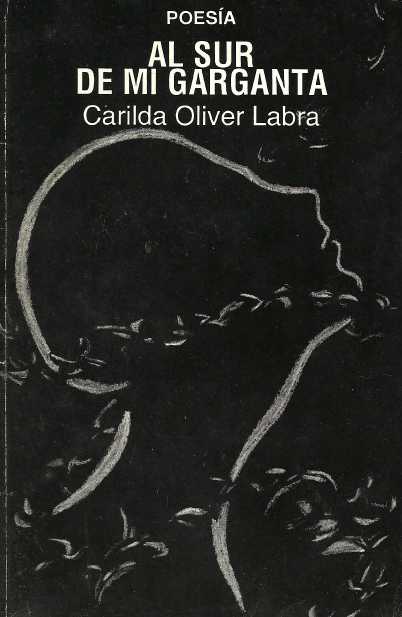4.1.3.3.1 “South of my throat”, 1949, by Carilda Oliver Labra (1922 – )

Although Carilda Oliver Labra had already published “Preludio lírico” in 1943, with a laudatory prologue by Fernando Lles y Berdayes, it was not until “Al sur de mi garganta” that she achieved public notoriety and a certain critical recognition, even being awarded the National Poetry Prize from the Ministry of Education in 1950 for this neo-romantic work, in which one can already appreciate, if not a poetic theory as such, which she was not interested in shaping, at least a notable awareness regarding the paths and risks of the profession.
The text appeared in its first edition preceded by this note of evident lyrical tone: “To publish verses is to discover truths that we didn’t even suspect inside and that would otherwise remain unconfessed. It is always the profanation of an ineffable intimacy. That’s why I hesitated to open my Poetry. But something strange and confusing happened: the words, trembling, began to rise without my permission, toward my throat, irremediably, from the south… I had to leave them on docile, moribund papers that could barely bear their weight. There they were erased. Then I came to understand the darkness of this destiny: they—who had been born to give themselves—were obliged to silence.
I wanted to be fair. I wanted to grant them their natural right to the light. Here they are: still sleepy, perfectly pure, without credentials; without the support of grace; with no presumption other than the elemental desire to live.”
In this collection of poems, the ease of youth is evident, although from a formal point of view it is quite polished and already presents Carilda’s particular associationism, sometimes concomitant with the insular surrealism of cultivators such as Félix Pita Rodríguez in “Corcel de fuego”.
From a psychological perspective, her middle-class origins are evident, aspiring to transcend the image society demanded of her gender and reveal herself as she truly is. This need for self-definition is reiterated in many of the pieces in the collection, including the first text, with the suggestive title “Elegy for My Presence,” which includes the following stanzas:
“I am on the earth, with my forehead,
saying goodbye to the clouds from the landscape.
I give a sigh to the setting sun:
I’m not going on a trip…
(…)
Let them not know my rainy attitude…
I want to be just a poor girl,
that blonde girl
similar to grass, bread and copper.
(…)
Tired of pretending
I am on earth in the mist
of all that exists:
the horizon, the tree and the foam;
“I don’t know how to die.”
The elegiac tone, as well as the titles, is present in many of the poems, undoubtedly imbued with neo-romanticism, with some reminiscence of the personal simplicity of Luisa Pérez de Zambrana that does not fully fit with the different personality of Carilda, the youthful need for self-definition and a sense of femininity that is centuries away from the collected attitude, as a faithful bride, of Zambrana.
Religiosity also runs through these pages, a certain questioning that has a vague reference in the biblical book of Job, but without rebellion. While he expresses his disdain, or rather, detachment, for certain social impositions, for “the people who call me doctor or miss,” he is interested in the minuscule and the helpless, and this is presented in a sentimental vein but without deplorable excesses; underlying all of this is a hylozoic conception rooted in love.
Another important element is the discovery of death in its immediate meaning of absence, as well as helplessness and poverty, which awaken a pain for the truth of things, faced with sincerity, open in this sense to the vicissitudes of life. His expression is primarily focused on closed stanza forms, such as the sonnet and other compositions, already demonstrating a style to which he would add new expressive gains throughout his life.








